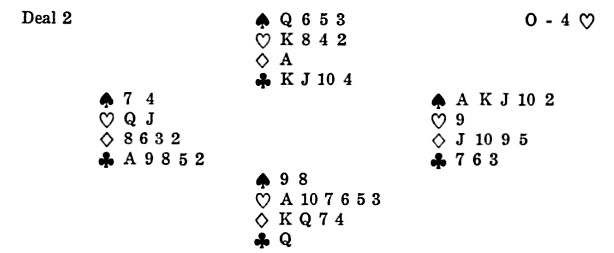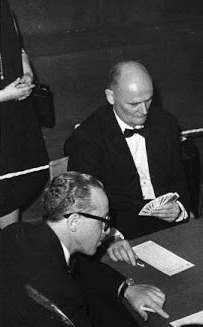Source: Master Play in Contract Bridge By Terence Reese
«There was no way in which I could tell.» How often is it true?
Early in the play, not often ; towards the end, never.
A universal example occurs when the right-hand defender, East, fails to lead up to obvious weakness in the dummy. The immediate inference should be that he has a high card of the suit, ace or king, and can stand a lead from his partner.
The next hand is more difficult. The clue is unsubstantial and is valid only with a first-class partner.

At most tables in a pairs contest South played in 4 after North had opened the bidding with 1
after North had opened the bidding with 1 and East had made an overcall of 1
and East had made an overcall of 1 .
.
The defence usually began with a spade to the  10, then
10, then  K followed by
K followed by  A. South ruffed high, crossed to
A. South ruffed high, crossed to  K, and discarded his club on
K, and discarded his club on  Q, so making the contract. It would be no better for East to lead a low spade at trick 3, for then South would discard his losing club.
Q, so making the contract. It would be no better for East to lead a low spade at trick 3, for then South would discard his losing club.
At one table an expert East realised that it might be necessary to cash a club before leading a third spade. He won the first trick with  10 and played well by returning a club to his partner’s ace. Had West now returned a spade, a third spade would have established a certain trump trick for the defence.
10 and played well by returning a club to his partner’s ace. Had West now returned a spade, a third spade would have established a certain trump trick for the defence.
West had other ideas, however. After winning with  A he returned a club for his partner to ruff. This gave declarer an overtrick.
A he returned a club for his partner to ruff. This gave declarer an overtrick.
West’s explanation sounded quite plausible. «When you won with the ten of spades and switched to a club, naturally I thought you had a singleton. It seemed so obvious for you to continue spades.»
Can you see any weakness in his argument? It is a good test. The answer is that if East had had a singleton club, and so wanted a club return, his right play at the first trick would have been to win with  A, not the
A, not the  10. The play of the ace would have suggested that there was no future in spades.
10. The play of the ace would have suggested that there was no future in spades.
